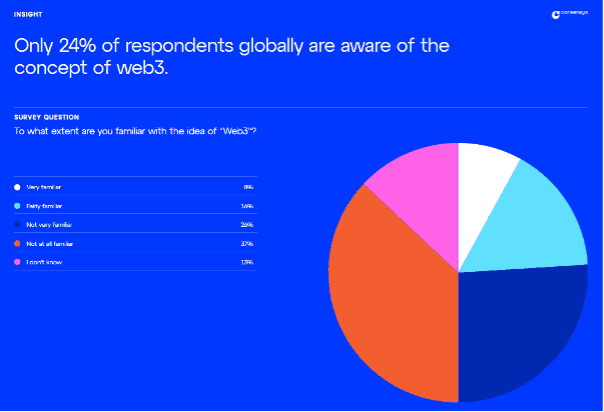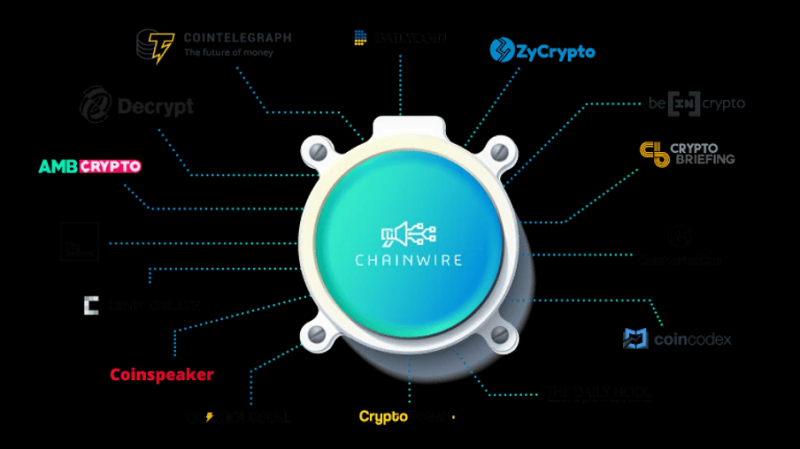Contents
As a crypto platform owner or Web3 startup, you’re no stranger to building in uncharted territory. You chose this decentralized frontier knowing it holds massive potential, but at the same time, some landmines see your project blow up in smoke.
As such, navigating this new landscape isn’t for the faint of heart. Yet, you embraced the risks with your MVP in hand, ready to stake your claim. But now, you need to reach potential users and convince them to jump on board. That’s where things get tricky.
See, the average crypto native might know their way around digital wallets and understand NFT potential. But for 99% of people, terms like “DeFi” and “DAOs” are still head-scratchers.
As much promise as it holds, the truth is most people still don’t have a clue what Web3 is all about. And why should they care?
That’s the marketing maze every Web3 business has to navigate.
But don’t fire up the panic sales just yet! In this guide, we’ll map out the inhospitable terrain, show you common pitfalls, and share battle-tested marketing strategies that will help you connect and resonate with your target audience. Think of it as your all-in-one survival guide for navigating the decentralized wilderness.

What is Web3 Marketing?
For the most part, traditional marketing relies heavily on channels like TV, radio, magazines, and search engines to promote to a broad audience. Strategies revolve around catchy ads, affiliate links, and influencer sponsorships designed to capture attention and then funnel traffic toward sales pages.
Web3 marketing operates differently. Instead of driving conversions through intermediaries, the focus lies in cultivating direct, mutually beneficial relationships between creator and community. In many cases, engagement occurs natively within Web3 environments like metaverses and on the platforms themselves.
Instead of flashy distractions, Web3 marketing is grounded in conveying genuine value. Brand loyalty stems from delivering transformative user experiences that resonate on an emotional level – not quick, hype-driven sales. Though still in its infancy, Web3 promotes marketing rooted in transparency, choice, and creative independence – principles that deepen bonds when executed skillfully.
Web3 Marketing Challenges
Despite the many advantages, Web3 marketing comes with hurdles that can hamper adoption and prevent conveying value to users effectively. Let’s explore the core obstacles:
Lack of Mainstream Understanding
Expect blank stares when you mention “Web3” to the average person. Even now, cryptocurrency and blockchain comprehension barely extend beyond Bitcoin. Concepts like decentralized finance, tokenized economies, and self-governing protocols baffle the majority.
As a result, most consumers remain oblivious to the metaverse and baffled by NFT’s meaning or use cases. Only 24% of respondents globally are even aware of the basic concept of web3, according to Consensys.

Image Source: Consensys
This steep learning curve and esoteric, technical landscape create significant engagement barriers and make generating interest an extremely uphill battle for developers trying to showcase Web3 benefits.
Difficulty Reaching Target Audiences
Even if people grasp Web3 basics, they fail to link innovations to daily applications that provide real value. For instance, conveying how NFT ticketing improves events by reducing scalping or how loyalty token rewards enhance customer experience seems abstract to the uninitiated.
And even if you reach potential users through targeted channels, clearly conveying complex platform advantages and use cases in relatable, non-technical terms is extremely tricky. Without that spark of understanding about tangible benefits over current solutions, messaging falls completely flat.
Winning Over Skeptical Users
High-profile crypto exchange hacks, pump-and-dump manipulation schemes, and obvious NFT money laundering reinforce overwhelmingly negative Web3 associations across consumers accustomed to Web2 landscapes.
Even legitimate innovations on blockchain platforms like supply chain tracking or programmable NFT art and assets trigger skepticism and confusion. Web3 carries an inherent distrust, with many consumers unsure how decentralization fixes Web2 flaws when risks seem amplified. Brands must put extra effort into proving security, reliability, and transparency around meddling, fraud, and theft to gain even basic levels of acceptance.
Stricter Decentralized Regulations
Web3’s independence ethos limits traditional advertising avenues built for centralized platforms with middlemen oversight. Crypto-based promotions spark intensified legal scrutiny regarding data privacy, accessibility requirements, and preventing hidden influencer sponsorships or disingenuous shilling.
Red tape abounds, heavily restricting marketing channels for decentralized applications and significantly increasing compliance costs. The open, decentralized model that lies at the heart of Web3’s appeal also hinders clarity for users and regulators alike, creating perception challenges.
Mainstream Media Bias and Misunderstanding
Finally, gaining positive coverage in mainstream outlets is hugely difficult for Web3 innovators. The majority of old-guard journalists simply do not grasp blockchain intricacies or decentralization’s transformative potential.
Oversimplification leads to the dismissal of innovations as “pointless jpegs” while disproportionately emphasizing risks like crypto crime. Such bias and misunderstanding inhibit communicating profound value. It also limits the mass audience reach needed to clarify myths versus reality. Inadequate visibility combined with predominantly negative coverage spreads FUD that further discourages mainstream acceptance essential for ecosystem growth.
5 Web3 Marketing Strategies to Overcome These Hurdles
Navigating Web3 marketing barriers requires specialized strategies tailored to decentralized spaces. Let’s explore targeted tactics to convey value amidst blockchain complexities:
1. Partnerships With Crypto Startups
Okay, forging partnerships may seem counterintuitive to the go-it-alone Web3 ethos. However, collaborating strategically provides reciprocal benefits.
Aligning with complementary blockchain startups raises awareness exponentially quicker than isolated efforts. A fledgling NFT ticketing marketplace, for instance, reaches vastly larger audiences by offering exclusive events for a trending PFP project. Joint giveaways similarly gain trust and social proof while accessing built-in communities.
Allowing a decentralized music streaming platform to provide albums as loyalty rewards engages its existing user base while increasing retention. Such creative incentives must offer clear utility for both party’s users. The streaming site gains exposure and potential subscription sign-ups, while the ticketing startup could receive a cut of streaming revenue.
The collaborative opportunities abound, but successful implementations require shared values and delivering differentiated utility versus business as usual. For ticketing, that may mean smart contracts that guarantee attendance via NFTs instead of paper tickets.
2. Web3-Tailored Press Release Distribution
Press releases are like those old-timey town criers announcing the latest happenings. Nowadays, they notify journalists of new developments, hoping for media coverage. But for crypto innovators, mainstream outlets rarely grasp blockchain intricacies accurately enough to cover news.
However, you still need PR strategies for major partnerships, shiny new funding rounds, or killer product launches. You want to shout it from the rooftops but in a way that resonates with decentralization aficionados.
That’s where specialized platforms like Chainwire come in – distributing announcements simultaneously across multiple crypto publications. Instead of wasting money on journalists missing technical subtleties, you directly tap niche news junkies already immersed in blockchain’s brave new world.

Image Source: Chainwire
It’s all about alignment. Tailored releases convey milestones to communities primed to realize their significance. Then, they interact and share within their niche networks. Accurate information, engaged audiences, organic amplification – that’s the win-win-win.
3. Harnessing the Power of Blockchain Influencers
In the world of Web3, influencers hold serious clout. These are OG crypto devotees who’ve been immersed in the crypto verse for years. They’ve built huge grassroots followings thanks to their knack for decoding complex concepts into bite-sized insights.
And because their audiences view them as trusted experts instead of corporate shills, they can work wonders spreading the word. It’s like having a super compelling recommendation, except it’s broadcast to tens of thousands of loyal niche followers.
Now you may be picturing some Televangelist type character promising people riches if they buy your token. However, finding the right influencer partnership is more nuanced than just paying someone to pump up a project. The key is aligning with crypto commentators who genuinely care about an initiative’s purpose. Collaboration should center on educating their communities about solving real problems or providing utility.
If it’s solely hype-building, followers will sniff that disingenuity out fast. But facilitate authentic connections between audiences and decentralized tools that enrich experiences? Then, you cultivate the holy grail – loyal brand advocates.
4. Building Hype the NFT Way
NFTs took the world by storm in 2021. News headlines touted record sales like Beeple’s $69 million “JPG FILE.”. But companies also realized these blockchain-verified assets could help hype products and engage communities in totally new ways.

Image Source: Adidas
Take fast food giant Taco Bell – they minted 25 limited edition taco-themed NFTs which sold out instantly. The buyer hype and media coverage from the stunt sparked major brand awareness despite negligible revenue.
Or Quentin Tarantino turning Pulp Fiction scenes into exclusive secret NFTs for diehard fans. He didn’t make a fortune but it got people excited and set up future drops. Essentially, brands are figuring out how to utilize NFT capabilities for experiences that wow audiences accustomed to Web2 tactics. Another example would be Adidas’s NFT partnership with the Bored Ape Yacht Club franchise which already boasts an almost cult-like following.
The key is to move beyond an NFT as purely a digital item to collect or flip. When tied to unlocking new product benefits and immersive brand adventures, it demonstrates an understanding of what makes Web3 so revolutionary.
5. Building Web3 Communities (Yes, Obviously)
We know… suggesting brands “build communities” is about as generic as advising musicians to “use social media”. It’s one of the most glaringly obvious Web3 marketing tactics.
But community building in decentralized ecosystems requires more nuanced strategies than simply gathering followers or racking up Discord members. The key differentiator? Web3 communities run on direct reciprocal value between brands and users. Where Web2 fosters parasocial, one-way relationships, Web3 facilitates collaborative partnerships through crypto tokens that power participation.
For example, envision a fictional “Sneakerverse” metaverse where users can showcase token-gated NFT shoes. Beyond just owning virtual kicks, token holders receive governance over ecosystem development decisions. This creates intrinsic involvement incentives beyond basic brand loyalty. Community feedback steers future 3D models, branded integrations, and environments based on what holders value most.
So, while gathering a Web3 community is Marketing 101, cultivating meaningful participation through tokenized utilities distinguishes revolutionary brands. Otherwise, you’re just another forgotten Twitter feed leaving users scrolling by.
Tapping On-Chain Insights for Personalized Experiences
Remember earlier when we covered the steep learning curve around Web3 concepts that limit mainstream adoption? Well, here’s where that infamous blockchain data transparency finally pays dividends.
On-chain activity like wallet transactions, token trading history, and even collectible ownership provide groundbreaking consumer behavior insights unseen since, well…ever.
Suddenly, marketers gain access to attention gold, like discovering what collaborations mega fans are engaging with most. Or which token reward tiers demonstrate longer community involvement.
Not only does this data enable better connecting with established audiences, but it also provides invaluable feedback for optimizing adoption. Patterns reveal friction points with onboarding flows or feature tweaks to boost retention.
The key is honoring transparency by using data judiciously to enhance experiences, not exploit audiences. With great power comes great responsibility – but when analyzed ethically, on-chain analytics unlock unlimited personalized engagement potential.
Wrapping Up
The decentralized frontier brings boundless marketing possibilities but requires reinventing strategies for the Web3 age. While risks exist in these uncharted waters, the old ways won’t suffice either.
Unique value propositions call for tailored solutions to convey complexity to niche audiences. Through creative collaborations, immersive experiences, and token-gated incentives, brands demonstrate comprehension of what sets Web3 apart.
It’s no longer about eyeballs and conversions but fostering reciprocal relationships where communities enrich brands as much as brands empower communities. The trademarks of this new paradigm? Openness, transparency, and placing practical utility for users first.
Disclaimer: CryptoPotato might have or might have had business relationships with some of the companies mentioned in the article.
